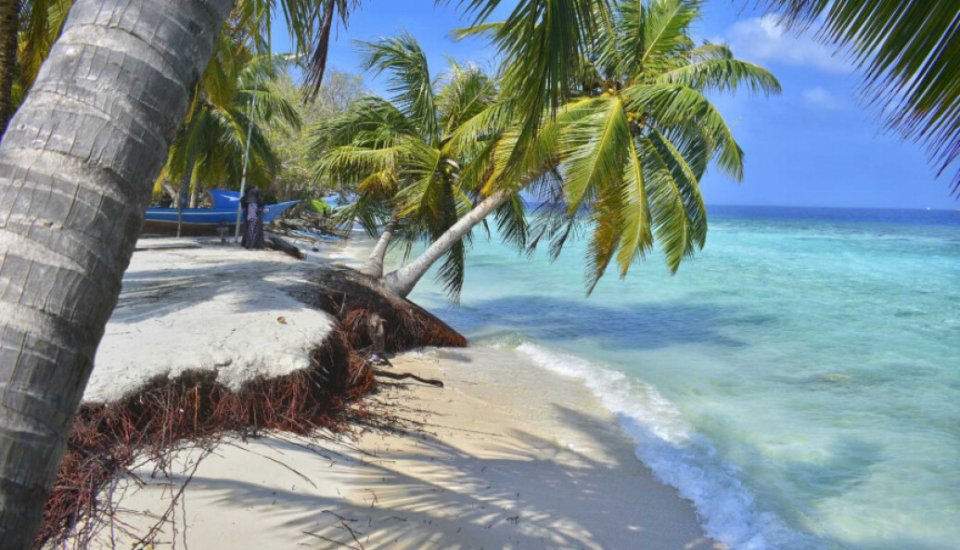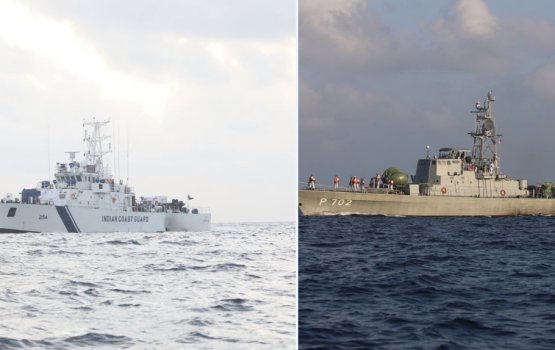The Maldives, a jewel in the Indian Ocean known for its postcard-perfect sandy beaches and crystal-clear waters, is now grappling with a formidable adversary - beach erosion. This unfolding crisis is not just a natural phenomenon but rather a confluence of factors, primarily driven by the ominous specter of climate change and compounded by various human activities. The implications of this pressing issue extend far beyond the environmental domain, reaching deep into the economic heart of the archipelago - its tourism sector, a linchpin of the nation's financial stability.
The escalating beach erosion crisis in the Maldives finds its roots in the broader global concern of climate change. The archipelago, consisting of 26 atolls, is particularly vulnerable to the consequences of a warming planet, where rising sea levels stand as a stark reminder of the imminent threat. The melting polar ice caps contribute to the elevating sea levels, subjecting the Maldives' coastline to a relentless battering, triggering erosion at an alarming pace.
However, climate change is not the sole perpetrator in this environmental drama. Human activities have emerged as accomplices, amplifying the destructive impacts. Unregulated urbanization, often driven by the rapid expansion of tourism infrastructure, disturbs the natural equilibrium of coastal processes. The extraction of groundwater, a consequence of growing human settlements, further weakens the delicate balance, rendering the once resilient beaches more susceptible to the erosive forces of the ocean.
The ramifications of the beach erosion crisis extend far beyond the shores, reaching into the very heart of the Maldives' economic lifeline - its tourism sector. The allure of the Maldivian beaches, with their pristine white sand and vibrant coral reefs, has been the primary magnet for millions of international tourists seeking a slice of paradise. However, the escalating erosion threatens to strip away this natural charm, rendering the destination less appealing to potential visitors.
The threat to the tourism sector is not merely aesthetic; it's economic. Resorts and hotels, strategically positioned along the coastline to offer panoramic views of the Indian Ocean, find themselves in the crosshairs of the encroaching waves. The very infrastructure that forms the backbone of the tourism industry is now at risk, facing damage that could have significant financial repercussions.
Beyond economic considerations, the crisis also jeopardizes the communities that rely on tourism for their livelihoods. Local populations, deeply intertwined with the tourism industry, face the prospect of displacement, disrupting not just their daily lives but also eroding the cultural authenticity that forms an integral part of the Maldivian experience.
As the Maldives confronts this dual assault from nature and human activity, the need for immediate and sustained action becomes paramount. Mitigation and adaptation strategies must be implemented with urgency. Sustainable tourism practices, emphasizing low-impact development and responsible tourism, can play a crucial role in minimizing the industry's negative impact on the environment.
Simultaneously, investing in innovative coastal protection measures, such as the restoration of coral reefs, beach nourishment, and the construction of seawalls, is essential to fortify the coastline against further erosion. However, these efforts are not isolated; they require a global commitment to combat climate change collectively. Reductions in greenhouse gas emissions and collaborative initiatives for climate adaptation are integral components of a comprehensive strategy to secure the Maldives' future as an unparalleled tourist destination.
Unraveling the Menace Behind Escalating Beach Erosion
For the Maldives, a nation comprising low-lying coral atolls dispersed across the Indian Ocean, the consequence of rising sea levels is nothing short of an existential threat. The gradual inundation of coastal areas is exacerbating the erosion crisis, as the relentless waves, now reaching further inland, eat away at the delicate balance that once defined the nation's pristine beaches.
The magnitude and speed at which sea levels are rising in the Maldives pose an unprecedented threat to the stability of its coastal ecosystems. The once protective barrier of shallow reefs and pristine sandy shores is now being breached, allowing the unrestrained force of the ocean to impact the vulnerable coastline, accelerating the erosion process at an alarming rate.
The Maldives, with its myriad islands and atolls, faces a unique vulnerability. The archipelago's very existence is intricately tied to the stability of its coastline, making the pervasive impacts of climate change particularly ominous. The slow but relentless encroachment of seawater into inhabited areas and the erosion of sandy shores not only imperil the natural beauty of the islands but also disrupt the delicate ecological balance that has sustained life in this oceanic haven for centuries.
From Coral Reefs to Coastal Retreat
Coral reefs, a critical natural defense against wave action, are being doubly impacted by climate change. Elevated sea temperatures, a direct consequence of global warming, trigger coral bleaching events, weakening the once vibrant and resilient reefs. The bleached and fragile corals are less effective in attenuating wave energy, making the coastline more susceptible to erosion. This dual assault, from rising sea levels and compromised coral reefs, leaves the Maldives grappling with a compounding ecological crisis.
In essence, climate change stands as the primary antagonist in the Maldives' beach erosion saga, sculpting a narrative of environmental vulnerability and human consequence. The escalating erosion crisis is an urgent call to action, demanding a global commitment to mitigate climate change, reduce greenhouse gas emissions, and safeguard the natural wonders that define the Maldivian paradise. As the nation grapples with the profound impacts of these environmental shifts, the need for international collaboration becomes more pronounced than ever to ensure the Maldives' survival in the face of this existential threat.
The intricate coral reefs that have long acted as natural protectors against wave action are now under duress due to coral bleaching. Elevated sea temperatures, symptomatic of climate change, are weakening these natural barriers, rendering them less effective in shielding the coastline from the erosive forces of the ocean.
Unmasking the Role of Anthropogenic Activities in the Maldives' Erosion Menace
Beyond the far-reaching impacts of climate change, the intensification of beach erosion in the Maldives is significantly exacerbated by the pervasive human footprint on these idyllic islands. Unregulated urbanization, excessive groundwater extraction, and unsustainable tourism practices collectively form a formidable alliance, contributing extensively to the erosion crisis and jeopardizing the very essence of the Maldivian coastal landscape.
Unregulated Urbanization
The Maldives, responding to the burgeoning demand for tourism, has witnessed rapid and unregulated urbanization, particularly in areas adjacent to its stunning coastlines. The construction of hotels, resorts, and infrastructure, often undertaken without due consideration for the delicate coastal balance, disrupts the natural processes that have shaped these islands for millennia. Coastal ecosystems, critical for mitigating erosion, are compromised as concrete structures replace the once porous and stabilizing sandy shores.
Excessive Groundwater Extraction
The archipelago's growing population and expanding tourist infrastructure have led to an increased demand for freshwater. As a result, excessive groundwater extraction has become a common practice. The indiscriminate removal of groundwater not only contributes to land subsidence but also alters the natural flow of freshwater to coastal areas, diminishing the stabilizing influence that water retention has on sandy soils. This, in turn, heightens the vulnerability of the coastline to the erosive forces of the ocean.
Unsustainable Tourism Practices
While tourism forms the economic backbone of the Maldives, certain unsustainable practices associated with the industry have become prominent contributors to the erosion menace. Ill-planned construction, over-exploitation of natural resources, and inadequate waste management not only degrade the environmental integrity of the islands but also directly impact the resilience of the coastal areas. Unsustainable tourism practices amplify the pressures on already fragile ecosystems, undermining their ability to withstand the dual assault of climate change and human activities.
Rapid Development of Resorts and Infrastructure
The rapid development of resorts and infrastructure, emblematic of the tourism boom in the Maldives, is a double-edged sword. While these developments contribute significantly to the nation's economy, they simultaneously pose a grave threat to the very landscapes that attract visitors. Construction projects alter natural drainage patterns, impede the movement of sediments along the coast, and disrupt the intricate balance of coastal processes. The consequences of this rapid development are starkly evident as once-pristine beaches succumb to erosion, leaving behind scars that mar the picturesque beauty of the islands.
Disruption of Coastal Processes
Construction projects not only alter the physical characteristics of the coastline but also disrupt crucial coastal processes that have evolved over millennia. The natural ebb and flow of sediment, essential for maintaining the equilibrium of the beaches, is interrupted by human interventions. The removal of sand dunes, alteration of natural vegetation, and the creation of hard surfaces all contribute to the disruption of these processes, leaving the coastline more susceptible to erosion.
Unveiling the Threat to the Maldives' Tourism Gem
The allure of the Maldives as a sought-after tourist destination is deeply embedded in the ethereal beauty of its pristine beaches. However, the relentless assault from beach erosion casts a shadow over this idyllic landscape, jeopardizing the very essence that has captivated millions of international visitors each year.
The Maldives has long been synonymous with paradise, with its postcard-perfect sandy beaches serving as the epitome of tropical allure. The powdery white sands, gently caressed by turquoise waters, create a visual symphony that has lured travelers from around the globe. These beaches are not just geographical features; they are the canvas upon which the Maldivian tourism experience is painted, providing a stage for unforgettable moments and everlasting memories.
The intensification of beach erosion poses a direct threat to this aesthetic masterpiece. As the shoreline recedes and the once-expansive beaches dwindle, the visual impact on the landscape is palpable. The gradual erosion not only alters the physical dimensions of the beaches but also undermines the pristine and unspoiled image that has been a hallmark of the Maldivian tourism brand.
The aesthetic charm of the Maldives, intricately tied to its pristine beaches, is under siege. The erosion-induced alterations in coastline contours, coupled with the disappearance of once-iconic stretches of sand, diminish the visual appeal that has been a pivotal factor in the nation's tourism success. The loss of this aesthetic charm represents more than just a change in scenery; it signifies a departure from the idyllic paradise that tourists seek, eroding the very essence of what makes the Maldives a unique and coveted destination.
International visitors, drawn by the promise of a tropical haven, arrive in the Maldives with certain expectations forged by the imagery of sun-kissed beaches and expansive shorelines. The erosion-induced transformation challenges these expectations, potentially leaving tourists with an altered and less enchanting experience than anticipated, especially in the local islands. The erosion-driven changes in the landscape may compromise the immersive and pristine environment that visitors seek, impacting their overall satisfaction and the likelihood of return visits.
The diminishing attractiveness of the Maldives' beaches holds significant economic implications for the nation's tourism sector. With the beaches serving as the primary draw, a decline in aesthetic appeal may result in decreased tourist interest and, consequently, a potential drop in visitor numbers. This, in turn, could lead to revenue loss, impacting the livelihoods of those dependent on the tourism industry, from local businesses to larger resorts.
Preserving and restoring the aesthetic allure of the Maldivian beaches become imperative not only for the sake of the tourism sector but also for the conservation of the nation's natural heritage. Efforts to mitigate erosion, restore damaged coastlines, and implement sustainable tourism practices are critical steps toward safeguarding the aesthetic charm that defines the Maldives' global image.
Unraveling the Risk to Coastal Resorts and Hotels
The encroaching menace of beach erosion in the Maldives is casting a shadow over the very foundations of the nation's tourism sector, as resorts and hotels perched along the coastline teeter on the edge of peril. The relentless waves, fueled by erosion, are increasingly breaching the natural defenses of these coastal establishments. Resorts, strategically designed to offer panoramic views of the Indian Ocean, now find themselves at the frontline of this environmental battle. As the waves make direct contact with the infrastructure, the once pristine and protective beaches are transformed into battlegrounds where the forces of nature clash with the foundations of the hospitality industry.
The financial implications of the impending infrastructure damage loom large over the Maldivian tourism sector, a vital economic lifeline for the archipelago. These resorts, which have served as the epitome of luxury and tranquility, now face the dual threat of immediate structural damage and long-term economic repercussions. The costs associated with repairing and fortifying against erosion-induced damage are substantial, placing an additional burden on an industry already grappling with the broader challenges of climate change and the ongoing erosion crisis. The integrity of coastal infrastructure is not merely a concern for individual resorts; it is a pivotal factor in maintaining the allure that draws tourists to the Maldives. The looming threat of damage, both physical and financial, underscores the urgent need for comprehensive strategies to protect and reinforce these vital components of the nation's tourism landscape.
Communities Displaced, Cultural Heritage at Risk
As the erosion crisis intensifies in the Maldives, it transcends beyond the physical impact on structures and extends its tentacles into the heart of local communities that depend on tourism for their livelihoods. Coastal villages and settlements, intricately connected to the tourism industry, now face the ominous specter of potential displacement. These communities, reliant on the economic activities generated by tourism, find themselves at the intersection of environmental vulnerability and economic fragility. The very foundations of their way of life are under threat as the encroaching waves of erosion compromise not only the physical structures that provide shelter but also the economic stability derived from tourism-related activities.
The potential displacement of these coastal communities introduces a complex layer of challenges, reaching far beyond immediate economic concerns. Disruption of established ways of life, traditions, and community bonds becomes an unavoidable consequence. These communities, often repositories of rich cultural heritage and traditions, face the risk of losing not just their physical homes but also the intangible fabric that weaves their unique identity. The cultural authenticity that has long been a magnet for tourists seeking an immersive experience in the Maldives is now at risk of erosion, mirroring the physical threat faced by the coastal landscapes.
The cultural heritage at stake extends beyond the immediate communities facing displacement. The Maldives, with its vibrant history and distinct cultural practices, has been a draw for tourists seeking more than just picturesque beaches. The erosion-induced challenges faced by local communities ripple through the broader narrative of the Maldives as a destination steeped in cultural richness. As these communities grapple with the potential upheaval caused by beach erosion, there arises an urgent need for comprehensive strategies that not only address the physical impacts but also safeguard the cultural authenticity that forms an integral part of the Maldivian experience. In navigating the complexities of the erosion crisis, the preservation of cultural heritage emerges as a critical pillar, ensuring that the unique tapestry of the Maldives remains intact amidst the challenges posed by environmental change.
Sustainable Tourism Practices
In the face of the escalating beach erosion crisis in the Maldives, the adoption of sustainable tourism practices emerges as a beacon of hope, offering a path towards environmental conservation and resilience. Central to this paradigm shift is the commitment to low-impact infrastructure development. By prioritizing designs that harmonize with the natural environment, resorts, and other tourism-related structures can minimize their ecological footprint. This includes elevated structures that account for potential sea-level rise and beach erosion, ensuring that the coastal landscape remains as untouched as possible. Furthermore, effective waste management strategies become imperative to prevent the pollution of marine and terrestrial ecosystems. A focus on waste reduction, recycling programs, and eco-friendly disposal methods can significantly mitigate the adverse effects of tourism on the environment, preserving the pristine beauty that attracts visitors to the Maldives.
Innovative Coastal Protection Measures: Safeguarding the Shorelines
Investing in innovative coastal protection measures stands as a crucial imperative to combat the impacts of beach erosion and fortify the Maldivian coastline against future threats. One such measure involves the restoration of coral reefs, which act as natural barriers against wave action. The rehabilitation and protection of these vital ecosystems contribute not only to beach stability but also to the preservation of marine biodiversity. Beach nourishment, involving the addition of sand or sediments to eroded shorelines, provides a proactive approach to replenishing lost beach areas. Additionally, the construction of seawalls becomes essential to shield vulnerable coastal infrastructure from the direct impact of waves and storm surges. These measures collectively serve as a comprehensive strategy to enhance the resilience of the Maldives' coastal areas, ensuring that the delicate balance between tourism and environmental preservation is maintained.
Collaborative Efforts for a Sustainable Future
While the adoption of sustainable tourism practices and innovative coastal protection measures is crucial, their effectiveness hinges on collaborative efforts at local, national, and international levels. The Maldives, as a frontline battleground against the impacts of climate change, requires not only internal commitment but also global cooperation. International partnerships, financial support, and knowledge exchange can bolster the implementation of sustainable initiatives and ensure that the Maldives remains a pioneer in sustainable tourism. By fostering collective responsibility for environmental conservation, the Maldives can not only navigate the challenges posed by beach erosion but also set a precedent for the global tourism industry, showcasing the transformative power of sustainability in safeguarding the natural wonders that make destinations like the Maldives unique and irreplaceable.
Navigating the Crossroads of Conservation and Prosperity
As the Maldives stands at the crossroads of environmental conservation and economic prosperity, the escalating beach erosion crisis emerges as a formidable challenge that demands immediate attention and concerted action. The Maldives, celebrated globally for its pristine sandy beaches and turquoise waters, is now grappling with a complex interplay of climate change and human activities, unraveling a narrative that extends far beyond the environmental realm. The repercussions of this pressing issue reach deep into the economic heart of the archipelago, threatening the very foundation of its tourism sector—a lifeline upon which the nation's financial stability depends.
The erosion crisis, beyond its environmental toll, extends into the heart of the Maldives' cultural identity. Local communities, intricately tied to tourism, face the prospect of displacement, disrupting not just their daily lives but also eroding the cultural authenticity that forms an integral part of the Maldivian experience. The very essence that makes the Maldives a unique and sought-after destination is at risk of being swept away by the relentless forces at play.
As the Maldives grapples with the profound consequences of beach erosion, the interconnectedness of environmental stability and economic prosperity becomes unmistakably clear. The challenges are complex, but the urgency of addressing them is undeniable. The plight of the Maldives serves as a poignant reminder to the global community—that in the face of environmental threats, the preservation of natural wonders is inseparable from the sustainability of economies and the well-being of communities. The Maldives stands as a beacon, urging the world to recognize the delicate balance between conservation and prosperity, forging a path towards a future where paradise is not just a memory but a legacy for generations to come.













